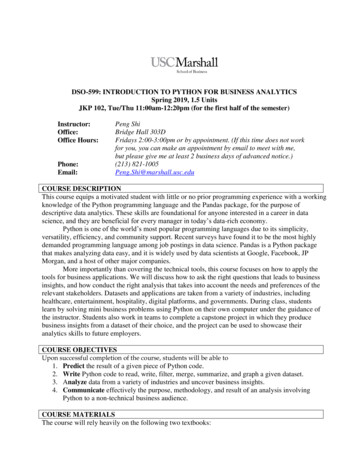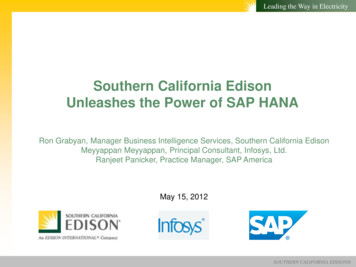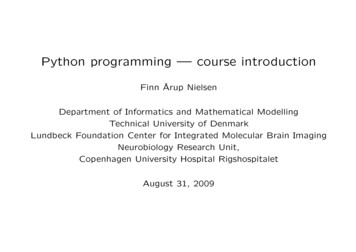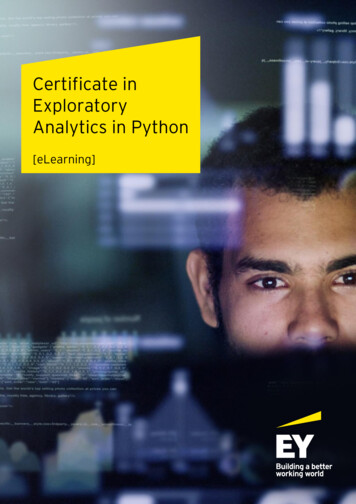
Transcription
DSO-599: INTRODUCTION TO PYTHON FOR BUSINESS ANALYTICSSpring 2019, 1.5 UnitsJKP 102, Tue/Thu 11:00am-12:20pm (for the first half of the semester)Instructor:Office:Office Hours:Phone:Email:Peng ShiBridge Hall 303DFridays 2:00-3:00pm or by appointment. (If this time does not workfor you, you can make an appointment by email to meet with me,but please give me at least 2 business days of advanced notice.)(213) 821-1005Peng.Shi@marshall.usc.eduCOURSE DESCRIPTIONThis course equips a motivated student with little or no prior programming experience with a workingknowledge of the Python programming language and the Pandas package, for the purpose ofdescriptive data analytics. These skills are foundational for anyone interested in a career in datascience, and they are beneficial for every manager in today’s data-rich economy.Python is one of the world’s most popular programming languages due to its simplicity,versatility, efficiency, and community support. Recent surveys have found it to be the most highlydemanded programming language among job postings in data science. Pandas is a Python packagethat makes analyzing data easy, and it is widely used by data scientists at Google, Facebook, JPMorgan, and a host of other major companies.More importantly than covering the technical tools, this course focuses on how to apply thetools for business applications. We will discuss how to ask the right questions that leads to businessinsights, and how conduct the right analysis that takes into account the needs and preferences of therelevant stakeholders. Datasets and applications are taken from a variety of industries, includinghealthcare, entertainment, hospitality, digital platforms, and governments. During class, studentslearn by solving mini business problems using Python on their own computer under the guidance ofthe instructor. Students also work in teams to complete a capstone project in which they producebusiness insights from a dataset of their choice, and the project can be used to showcase theiranalytics skills to future employers.COURSE OBJECTIVESUpon successful completion of the course, students will be able to1.2.3.4.Predict the result of a given piece of Python code.Write Python code to read, write, filter, merge, summarize, and graph a given dataset.Analyze data from a variety of industries and uncover business insights.Communicate effectively the purpose, methodology, and result of an analysis involvingPython to a non-technical business audience.COURSE MATERIALSThe course will rely heavily on the following two textbooks:
Chapters 1-9 of “Python for Everybody” by Charles R. Severance, available athttps://www.py4e.com/book.php. (Both the PDF and HTML versions are free.)- Chapters 1-10 of “Pandas for Everyone” by Daniel Y. Chen, available for purchase onAmazon.com or Pearson.com. (Cost is around 30 for the print edition.)Datasets and additional readings will be posted on Blackboard at least one week before they are used.If you have any questions or need assistance with the Blackboard Course Pages, please contact theMarshall HelpDesk at 213-740-3000 or HelpDesk@marshall.usc.edu.-PRE-REQUISITESWhile no prior programming experience is assumed, students are expected to be able to proficientlyoperate a word processor, web browser, and to save files from the Internet and organize them intofolders.This course also requires students to have access to a laptop that they can bring to class withPython 3, Jupyter notebook, and the Pandas package installed. All of these are available via installingthe latest Miniconda or Anaconda distribution for Python 3.X, available at . You should complete the installation as soon as possible, preferablybefore the first class session. Using Miniconda or Anaconda to install Python, Jupyter and Pandas,rather than using another method, will minimize technical difficulties.COMMUNICATION POLICYI am committed to respond to your email within 24 hours if it is received on a business day during9am-5pm. If it is received in the evenings or on the weekends, then I will treat the email as if it wasreceived at 9am the following business day, and respond within 24 hours from then. (For example,for an email received on Monday at 3pm, I will respond by Tuesday at 3pm. For an email received atMonday at 6pm, I will respond by Wednesday at 9am. For an email received on the weekend betweenFriday 5pm and Monday 9am, I will respond by Tuesday 9am. If it were a long weekend and Mondayis a holiday, then I will respond by Wednesday 9am.)CLASSROOM POLICYStudents are expected to have completed all of the designated readings before class. Learningprogramming requires repeated exposure and practice, so it is recommended that you not onlyread the textbooks but also follow the code tutorials in them by typing the Python commandsyourselves on a computer as you read.Students should bring a computer to each class, but should only use it during the time allottedfor the hands-on coding activity. During all other times, students should close all laptops and refrainfrom using cell-phones or tablets. When computer use is not allowed, students should take notes byhand using paper. Throughout the duration of the class, students should not access Facebook,YouTube, Twitter, Instagram, or any other website that is not related to the course. Each violation ofthe above policy will result in a point deduction to one’s “In-class work.”GRADINGYour final grade will be based on your absolute performance with respect to the following criteriaand weights, as well as on your relative performance compared to other students taking the course.The target average GPA for this course is 3.5.AssignmentsIn-class WorkQuizzesCoding AssignmentsPoints14620% of Overall Grade14%6%20%2
Project ProposalProject DeliverableFinal ExamTOTAL10252510010%25%25%100%IN-CLASS WORKStarting from the second class, students will complete hands-on mini-assignments in class, in whichthey apply the skills learned to various business settings. These mini-assignments are to be submittedon Blackboard before the start of the next class session, and grading is by timely completion only.QUIZZESThere will be two 15-minutes quizzes held at the beginning of class, each worth 3%. Students areallowed to use any paper books or notes for the quiz, but no electronic devices (laptops, cellphones ortablets) are allowed. The quizzes are designed to assess course learning objectives 1 and 2 (predictingthe result of given Python code or to write code related to data analytics). The questions for quizzesare analogous to those given in Interviews involving data Analytics. The dates of quizzes are listed inthe schedule at the end of the syllabus. No rescheduling of quizzes is allowed. If you miss a quiz, theweight will be automatically transferred to the final exam.CODING ASSIGNMENTSThere are two individual assignments that focus on learning objective 2 (ability to write Pythoncode). The assignments are worth 10% each and are based on the following business applications.- Assignment 1: Streamlining Healthcare Operations by Automating a Decision Rule.Studies have shown that healthcare outcomes can improve if the health provider canstreamline its operations using precise decision rules to reduce human error. This can alsoimprove the operational efficiency and lower the strain on limited time of doctors and nurses.In this assignment, you will use basic Python constructs to build an automated tool that triagesan incoming patient by asking a series of questions to determine the appropriate next step.-Assignment 2: Analyzing Data from Customer Reviews. One challenge for marketing andsales teams is to analyze large amounts of unstructured text data, such as customer reviews. Inthis assignment, you will apply your understanding of basic data structures in Python andPandas to read a large file of free text input and extract repeated words, while counting theirnumbers of occurrences. You will output the results in a structured table that is moreamenable to future analysis. This is similar to the “highlights” feature in Yelp.TEAM PROJECTStudents will be assigned into teams of about 3-4 students by the instructor and will work in theirown time outside of class to complete a Python “code portfolio” that they can show future employersto demonstrate their proficiency. Each portfolio should consist of one or more Jupyter notebooksposted on Github, and should focus on analyzing a particular set of data to uncover business insights.The analysis will not only be graded based on the use of Python, but also on the logic, presentation,rigor, and business relevance. Students are encouraged to find their own datasets rather than usingthose from in-class activities. There are three deliverables for the team project:- Proposal (10%): a Jupyter notebook describing the dataset, basic descriptive features of thedata, and a plan for more in-depth analysis. The notebook should clearly describe the purpose,methodology, and anticipated result of the analysis to a non-technical business audience.- Final deliverable (25%): the completed portfolio, composed of one or more Jupyternotebooks. They should be written with a target audience of a manager in a relevant company3
and should be written with clear descriptions and explanations that are understandable to anon-technical audience.With the submission of the final deliverable, each individual will complete a survey describing his orher own contribution to the project, as well as a breakdown of the percentage of total work performedby each person in the team. The breakdown must add up to 100% and must include yourself. Thiswill be used to adjust individual grades if certain members contributed little. Detailed instructions andgrading rubric for each deliverable will be posted on Blackboard well before they are due. The teamproject assesses course learning objectives 2, 3, and 4 (writing Python code, analyzing data, andcommunicating to a non-technical audience.)FINAL EXAMThere will be a 75-minute exam during the last class session. The exam is open book and open notes,but no electronic device is allowed, including laptops, cellphones, and tablets. Types of questionsmay include commenting on the logic of a certain data analysis, predicting the output of codesamples, as well as completing code segments. Learning to code on paper without the feedback of acomputer will advance your coding abilities and will be useful for certain interviews in the future.The exam is worth 25% of your total grade and assesses course learning objectives 1, 2, and 3(predicting outputs, writing code, and analyzing data).EXAM RESCHEDULINGStudents must attend the final exam at the indicated time and date. If you foresee a conflict, you mustcontact the professor within the first two weeks of the semester to explore alternative options. Norescheduling of exam will be allowed after the first two weeks of class. The only exception is adocumented medical or family emergency, for which the student must either provide a signed doctor’s note with the name and phone number of the medical professional verifying the medicalemergency, or have a professional counselor contact the professor directly verifying the nature andseriousness of the emergency. For all other reasons of missing the exam, including travels for nonemergencies, interviews, adverse traffic conditions, or forgetfulness about exam time, the student willnot be allowed to reschedule and will receive a zero for the exam.LATE SUBMISSIONS POLICYAssignments must be submitted electronically via Blackboard before it is due. If your internet breaksdown on the due date, you must deliver a hard copy printout at the beginning of class on that day. Ifyou are unable to attend class on that day, make arrangements for it to be delivered to the classroomor to my office by the start of class. There is an automatic 10% deduction for any lateassignment, even if it is late only by a few minutes. For every 12 hours of additional lateness,there is an additional 10% deduction. (The Blackboard timestamp is the definitive authority thatwe use for submission time.) For example, a project proposal that would have gotten a grade of 85%that is five minutes late will receive a grade of 75%. If it is 13 hours late, it will receive a grade of65%. If it is 25 hours late, it will receive a grade of 55%. The deductions continue until the gradereaches zero.RE-GRADING POLICYI will do my best to make my expectations for the various assignments clear and to evaluate them asfairly and objectively as I can. If you feel that an error has occurred in the grading of any assignment,you may, within one week of the date the grade is assigned, write me a memo in which you explainfully and carefully why you think the assignment should be re-graded. Be aware that the reevaluation process can result in three types of grade adjustments: positive, none, or negative.4
TEAM WORKFor any career related to business analytics, it is important that you work well in teams. Most teamsin the workplace are assigned by others rather than chosen by team members. Therefore, you mustlearn to work effectively in the assigned teams. The teams for the final project are designed tomaximize diversity of background and expertise and will be announced on Blackboard. The teamassignments may be imperfect but you must work with it. The instructor will not act as anintermediary in any team disputes; you must learn to work out differences among yourselves.THE IMPORTANCE OF COURSE EVALUATIONSThis course is continuously improved, based on feedback from students and instructor observations.Please participate in the midterm and end-of-term course evaluations online. Your feedback isessential to ensuring that Marshall meets student needs. Your instructor will read each evaluationcarefully and address the feedback in future iterations of the course.STATEMENT ON ACADEMIC CONDUCT AND SUPPORT SYSTEMSAcademic Conduct:Plagiarism – presenting someone else’s ideas as your own, either verbatim or recast in your ownwords – is a serious academic offense with serious consequences. Please familiarize yourself with thediscussion of plagiarism in SCampus in Part B, Section 11, “Behavior Violating University Standards”policy.usc.edu/scampus-part-b. Other forms of academic dishonesty are equally unacceptable. Seeadditional information in SCampus and university policies on scientific duct.Although students may discuss the individual coding assignments, students are expected towrite their codes independently, so as to avoid involuntary plagiarism. No communication betweenstudents is tolerated during a quiz or an exam. Any suspicion of plagiarism or cheating will be reportedand investigated. Students are encouraged to report any suspicious behavior of peers; the identity of thestudent who reports cheating will be held confidential. Any documented act of plagiarism or cheatingwill result at a minimum in a failing grade of “F” for all responsible parties and accomplices, anddepending on the result of the investigation, may also result in higher penalties such as suspension orexpulsion. In order to uphold the academic integrity of the university, such disciplinary actions will beexecuted without mercy on the first violation.Students with Disabilities:USC is committed to making reasonable accommodations to assist individuals with disabilities inreaching their academic potential. If you have a disability which may impact your performance,attendance, or grades in this course and require accommodations, you must first register with theOffice of Disability Services and Programs (www.usc.edu/disability). DSP provides certification forstudents with disabilities and helps arrange the relevant accommodations. Any student requestingacademic accommodations based on a disability is required to register with Disability Services andPrograms (DSP) each semester. A letter of verification for approved accommodations can beobtained from DSP. This letter must be delivered to the professor by the end of the third week ofclass in order to apply accommodations for this course. DSP is located in GFS (Grace FordSalvatori Hall) 120 and is open 8:30 a.m.–5:00 p.m., Monday through Friday. The phone number forDSP is (213) 740-0776. Email: ability@usc.edu.Support Systems:Student Counseling Services (SCS) - (213) 740-7711 – 24/7 on callFree and confidential mental health treatment for students, including short-term psychotherapy, groupcounseling, stress fitness workshops, and crisis intervention. https://engemannshc.usc.edu/counseling/5
National Suicide Prevention Lifeline - 1-800-273-8255Provides free and confidential emotional support to people in suicidal crisis or emotional distress 24hours a day, 7 days a week. ip & Sexual Violence Prevention Services (RSVP) - (213) 740-4900 - 24/7 on callFree and confidential therapy services, workshops, and training for situations related to gender-basedharm. https://engemannshc.usc.edu/rsvp/Sexual Assault Resource CenterFor more information about how to get help or help a survivor, rights, reporting options, andadditional resources, visit the website: http://sarc.usc.edu/Office of Equity and Diversity (OED)/Title IX compliance – (213) 740-5086Works with faculty, staff, visitors, applicants, and students around issues of protected class.https://equity.usc.edu/Bias Assessment Response and SupportIncidents of bias, hate crimes and microaggressions need to be reported allowing for appropriateinvestigation and response. ponse-support/USC Support & Advocacy – (213) 821-4710Assists students and families in resolving complex issues adversely affecting their success as astudent EX: personal, financial, and academic. https://studentaffairs.usc.edu/ssa/Diversity at USC – https://diversity.usc.edu/Tabs for Events, Programs and Training, Task Force (including representatives for each school),Chronology, Participate, Resources for StudentsUSC Emergency InformationProvides safety and other updates, including ways in which instruction will be continued if an officiallydeclared emergency makes travel to campus infeasible. emergency.usc.eduUSC Department of Public Safety – UPC: (213) 740-4321 – HSC: (323) 442-1000 – 24-hour emergencyor to report a crime.Provides overall safety to USC community. dps.usc.eduGrade Disputes:All grades assigned by faculty members are final. Students have the right to seek explanation,guidance, counsel and reasons for the assignment of a grade. Faculty may initiate a change in grade ifthere is an error in the calculation of a grade. Students may appeal a grade according to universitypolicy as set forth in SCampus. A faculty member may not change a disputed grade outside theformal appeals process. In response to a disputed academic evaluation by an instructor, a student isentitled to two levels of appeal after review by the instructor: first to the chairperson of the department and then to the appropriate dean of the school. The full university policy can be found inSCampus under University Governance / Academic Policies at https://policy.usc.edu/scampus-partc/.6
COURSE OUTLINE AND ASSIGNMENTSThis course is organized into four modules. Each module corresponds to a series of businessquestions, which motivate the in-class work and coding assignment for that module.MODULE I. Programming Logic (Sessions 1-4)How does a computer program work? This module presents a primer on the building blocks of aprogram and how to logically sequence the components to perform a complex task. The moduleculminates in assignment 1, in which you apply these tools to improve healthcare operations.Business Questions: How to break down a complex task into well-defined steps? (This problem occurs in everyaspect of business and training in “programming thinking” helps a lot.) How to automate manual tasks to improve operational efficiency and reduce human error? How to bridge the language barrier between business executives and computer engineers?Session 1 – Introduction to Programming Pre-class reading: Chapter 1 of “Python for Everybody” by Charles Severance. Due before class: Pre-course survey (link on Blackboard) Learning Objectives:o Describe the building blocks of a Python program.o Type and run a Python program within Jupyter notebook.o Describe various types of errors and how to debug.o Identify the business goal of an application of business analytics.Session 2 – Variables, Statements and Conditional Execution Pre-class reading: Chapters 2 and 3 of “Python for Everybody” by Charles Severance. Learning Objectives:o Store intermediate outputs in variables.o Describe common variable types and determine the type of a variable.o Use Python for computing arithmetics.o Use if statements to control the flow of execution.Session 3 – Functions Pre-class reading: Chapters 4 of “Python for Everybody” by Charles Severance. Learning Objectives:o Load and read documentation for built-in functions and call them.o Define own function with proper syntax.o Use common built-in functions such as type, max, min, len, and type conversions.Session 4 –Iterations Pre-class reading: Chapters 5 of “Python for Everybody” by Charles Severance. Learning Objectives:o Simplify repetitive code using for and while loops.o Controlling programmatic flow within loops using break and continue.MODULE II. Data Structures (Sessions 5-8)How should data be stored in a particular business setting and what are the tradeoffs involved? Thismodule introduces you to the fundamental data structures in Python and Pandas. You will make use7
of all of them in Assignment 2, in which you write a program to extract insights from large amountsof customer reviews.Business Questions: How to store a particular kind of business data to make the analytics efficient? How to analyze large amounts of unstructured text data? What are the relevant slices of data for a given business decision and how to retrieve theimportant parts and filter out the rest?Session 5 – Strings and Files Pre-class reading: Chapters 6 and 7 of “Python for Everybody” by Charles Severance. Due before class:o Coding Assignment 1 (Streamlining healthcare operations by automating a decisionrule)o Quiz 1 will take place in the first 15 minutes of class and will cover contents fromsessions 1-4. Learning Objectives:o Parse a text files and store the relevant part into strings.o Slice, manipulate and format strings.o Define a Python object and describe the meaning of the dot notation.Session 6 – Lists and Dictionaries Pre-class reading: Chapters 8 and 9 of “Python for Everybody” by Charles Severance. Learning Objectives:o Define and manipulate Python lists and dictionaries.o Describe the differences between lists, dictionaries and tuples.o Use a Python dictionary to perform word counts.Session 7 – Pandas DataFrame Basics Pre-class reading: Chapter 1 of “Pandas for Everyone” by Daniel Chen. Learning Objectives:o Load a simple delimited data file.o Count how many rows and columns were loaded.o Determine which type of data was loaded.o Examine different parts of the data by subsetting rows and columns.Session 8 – Pandas Data Structure Pre-class reading: Chapter 2 of “Pandas for Everyone” by Daniel Chen. Learning Objectives:o Load in manually created data.o Describe the basic properties and operations of the Series and DataFrame objects.o Create a subset of the data via fancy slicing and indexing.o Save data from a Pandas object into a file.MODULE III. Basic Analysis (Sessions 9-11)A significant amount of time spent by entry-level data analysts is in gathering messy, incomplete datafrom various sources and assembling them into a coherent dataset, as well as drawing simple plots todescribe the data. This module introduces the basic techniques in Pandas for plotting, assembling, and8
handling missing data. You have the opportunity to practice these skills when assembling a suitabledataset for the team project, and writing your project proposal, which is due at the end of the module.Business Questions: How to tell compelling stories using data and plots? For a given business decision, what data might be helpful and where to find them? How to integrate data from various sources? What to do about missing data?Session 9 – Introduction to Plotting Pre-class reading:o Chapter 3 of “Pandas for Everyone” by Daniel Chen.o “Pandas Dataframe: Plot Examples with Matplotlib and Pyplot” (posted onBlackboard)o “The Challenger: an information disaster” (posted on Blackboard) Due before class:o Coding Assignment 2 (Analyzing Data from Customer Reviews)o Quiz 2 will take place in the first 15 minutes of class and will cover contents fromsessions 5-8. Learning Objectives:o Describing the various packages for plotting in Python and their relationships.o Creating line plots, scatter plots, bar plots with matplotlib and Pandas and customizingthe formatting.o Creating histograms, density plots, regression plots, pairwise plots, and facetted plotswith seaborn.Session 10 – Data Assembly Pre-class reading: Chapter 4 of “Pandas for Everyone” by Daniel Chen. Learning Objectives:o Define the term “tidy data.”o Concatenating data in Pandas.o Merging multiple DataFrames.Session 11 – Missing Data Pre-class reading: Chapter 5 of “Pandas for Everyone” by Daniel Chen. Learning Objectives:o Describe how missing data is represented in Pandas.o Describe how missing values are created in data processing.o Recoding and making calculations with missing values.MODULE IV. Data Munging (Sessions 12-14)Data munging, also known as data wrangling, is the process of transforming raw data into anotherformat with the intent of making it more appropriate for analysis. It is the bread and butter of a dataanalyst and learning to do this efficiently can give you an enormous edge.Business Questions: How to efficiently transform and aggregate large amounts of data in the least amount ofcoding time?9
How to clean the mess in the data to identify the underlying story?Session 12 – Tidy Data and Data Types Pre-class reading: Chapter 6-7 of “Pandas for Everyone” by Daniel Chen. Due before class: Project proposal Jupyter notebook. Learning Objectives:o Using the melt and split functions to reorganize data.o Loading multiple data files automatically.o Identify the data types of columns in a Dataframe.o Converting between various data types.o Manipulating categorical data types.Session 13 –Text Data Pre-class reading: Chapters 8 of “Pandas for Everyone” by Daniel Chen. Learning Objectives:o Using Pandas string methods to manipulate columns containing text.o Transforming strings into the desired format.o Using regular expressions to search for a pattern.Session 14 – Pandas Apply and Groupby Operations Pre-class reading: Chapter 9-10 of “Pandas for Everyone” by Daniel Chen. Learning Objectives:o Applying a custom function over columns or rows.o Using pre-made Pandas functions over columns or rows.o Describe the “split-apply-combine” framework for data transformation.o Using the “groupby” operation to implement the above in Pandas.Session 15 – Review Learning Objectives:o Practice solving questions similar to those in the exam.o Describe how everything learnt in the course fit together.Session 16 – Final ExamDue on Friday 3/1 at 6pm Pacific Time: Final project deliverable.10
COURSE OUTLINE AND ASSIGNMENTS (SUMMARY TABLE)ModulePre-classReadingsPY4E Ch. 1Pre-class surveyVariables, Statements andConditional ExecutionFunctionsPY4E Ch. 2-3Assignment 0IterationsPY4E Ch. 5Strings and FilesPY4E Ch. 6-7Session 6(Thu 1/24)Lists and DictionariesPY4E Ch. 8-9Session 7(Tue 1/29)Pandas DataFrame BasicsPD4E Ch. 1Session 8(Thu 1/31)Pandas Data StructurePD4E Ch. 2Introduction to PlottingSession 1(Tue 1/8)I. ProgrammingLogicSession 2(Thu 1/10)Session 3(Tue 1/15)Session 4(Thu 1/17)Session 5(Tue 1/22)Session 9(Tue 2/5)II. Data StructuresTopicIntroduction toProgrammingPY4E Ch. 4Session 10(Thu 2/7)Data AssemblyPD4E Ch. 3,Additional readingson BlackboardPD4E Ch. 4Session 11(Tue 2/12)Missing DataPD4E Ch. 5Tidy Data and Data TypesPD4E Ch. 6-7Session 13(Tue 2/19)Text DataPD4E Ch. 8Session 14(Thu 2/21)Apply and GroupbyOperationsPD4E Ch. 9-10Session 15(Tue 2/26)Exam ReviewSession 12(Thu 2/14)Session 16(Thu 2/28)-III. Basic AnalysisIV. Data MungingAssignments DueFinal Exam (In Class)Assignment 1,Quiz 1Assignment 2,Quiz 2Project ProposalProjectDeliverable due6pm Friday 3/1.PY4E denotes the textbook “Python for Everybody” by Charles Severance.PD4E denotes the textbook “Pandas for Everyone” by Daniel Chen.The in-class work for each session is due on Blackboard before the next session.11
After carefully reviewing the above syllabus, please complete the following and return a hard copy tothe instructor by the second week of class.Acknowledgement of UnderstandingI, , USC # , herebyacknowledge that I have carefully reviewed the DSO 599 (Introduction to Python for BusinessAnalytics) syllabus in Spring 2019 and that I fully understand and agree to the policies writtentherein. Specific policies include:- Any documented act of plagiarism or cheating for an assignment or a test will result, at aminimum, in a failing grade of F for the course with no option of withdrawal for allresponsible persons. The penalty will be applied without mercy upon the first offence.- No exam rescheduling is allowed after the first two weeks of class. Except for documentedmedical or family emergencies, missing the exam will result in a grade of zero.- DSP students must provide the instructor with the official letter of verification by the thirdweek of class for any accommodations to be applied for this course.- No use of laptops, tablets, and cellphones du
DSO-599: INTRODUCTION TO PYTHON FOR BUSINESS ANALYTICS Spring 2019, 1.5 Units JKP 102, Tue/Thu 11:00am-12:20pm (for the first half of the semester) Instructor: Peng Shi Office: Bridge Hall 303D Office Hours: Fridays 2:00-3:00pm or by appointment. (If this time does not work for you, you can make an appointment by email to meet with me,










